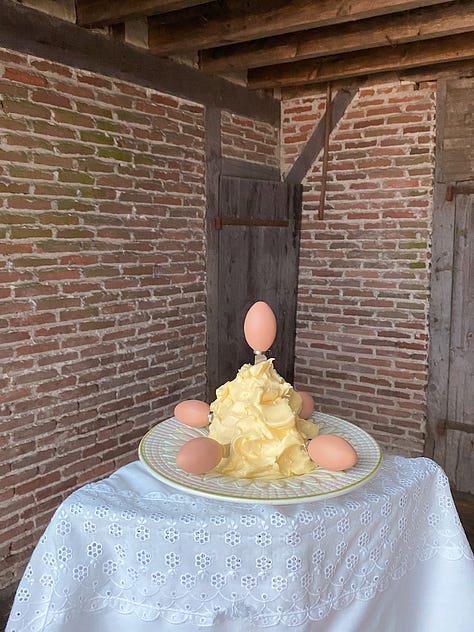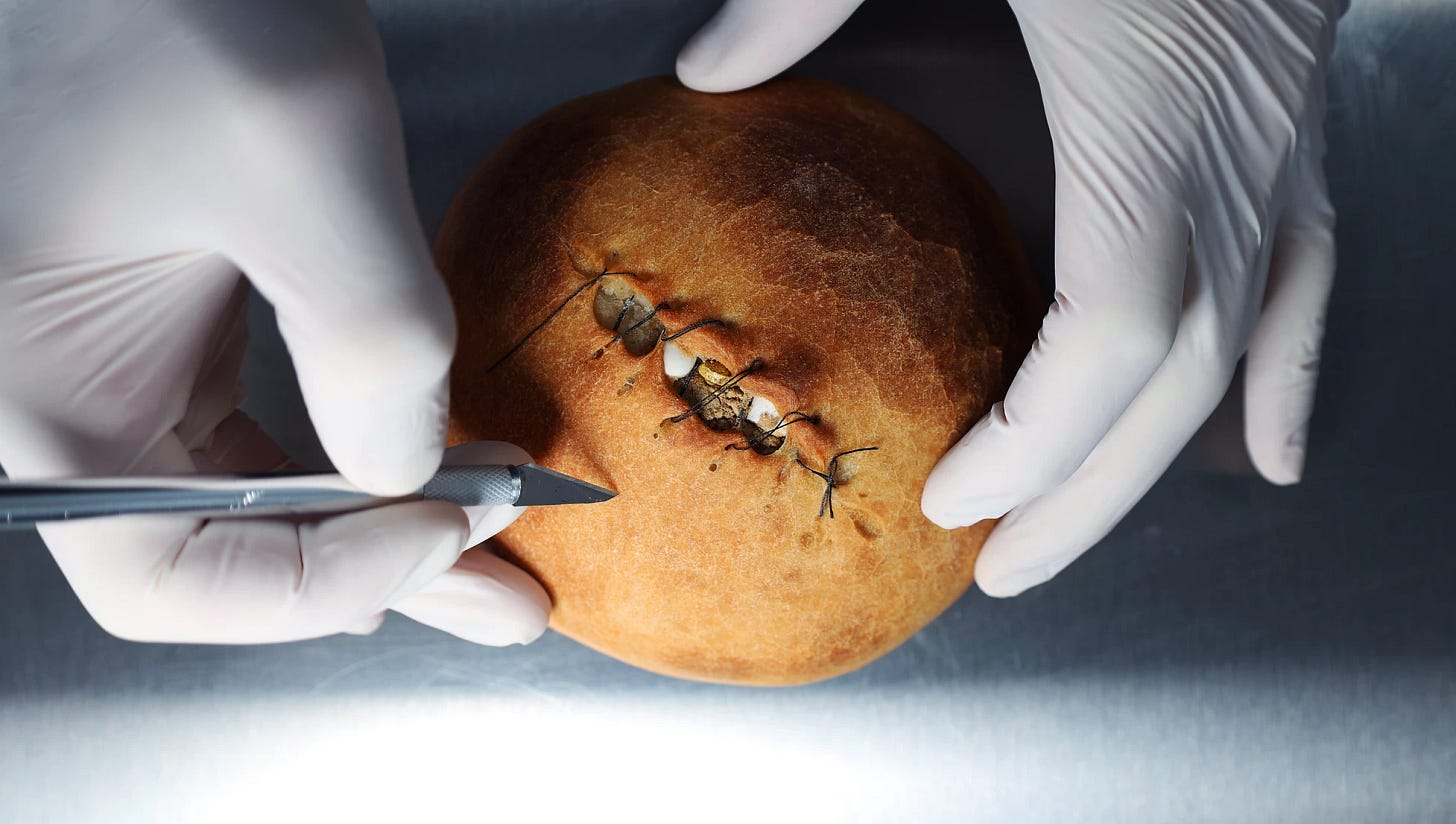7 Artists Exploring Food As A Medium To Follow Now
In the era of social media, with people wanting to engage with food and learn about its history, seasonality and more, I wanted to highlight the artists exploring food as an artistic medium.
One of my wishes for 2024 was to write more consistently on my Curious Curator Substack, and another was to collaborate on multi-disciplinary food installations, organise experience and discourse-led supper clubs, and follow my passion, focusing on the intersection between food and art. While planning and researching, I wanted to highlight seven artists and designers exploring food as a medium with whom I wanted to share their multi-faceted practices.
Inês Neto dos Santos is a multi-disciplinary artist born in Lisbon and based in London/Brussels. She completed an MA in Visual Communication at the Royal College of Art (2016) and a BA in Graphic Design and Illustration at the London College of Communication (2013). Her practice moves between performance, installation and social sculpture, investigating food in its intertwined socio-political, cultural and ecological dimensions. Through her work, Inês creates contexts and frameworks to explore collaboration, generosity, care and togetherness.
In recent years, she has delved into fermentation's practical and symbolic dimensions as a gateway into our enmeshed, multispecies existence. More recently, Inês' research has taken her into studying beans and their soil regeneration qualities, investigating their relationship to supported sustenance and care.


I first met Inês in early 2018 when she had recently graduated from the Royal College of Art and had created this magical installation titled Sacred Elements for the exhibition I co-curated with artist Anna Skladmann called Adventitious Encounters. The space was in an abandoned office space in a defunct shopping centre before it got torn down and turned into luxury apartments. In a fleeting and convivial way, I think this was the first food installation and creative approach to food I had encountered. I loved Inês' artistic interpretation of her response to the exhibition and use of ferments. After that, we decided to collaborate on the Tender Touches exhibition, which later turned into a publication.
Since March 2021, Inês has co-led the online course Food Cosmogonies as a part of The Gramounce with artist Nora Silva, first at the Institute for Postnatural Studies in Madrid and currently in collaboration with the Barns Art Centre, NY.


For more about Inês's practice, you can also read our in-conversation here.
Nora Silva is a Spanish-Chilean researcher and artist based in London and Madrid. She graduated from the Royal College of Art in July 2017 and, as an artist, has performed at leading UK institutions such as Tate Exchange, Design Museum and Camden Arts Centre in London. Nora uses performance as a signifying tool, an active process in the genesis of alternative cosmologies, as a mechanism to resist imposed subjectivities. As a researcher, Nora is interested in the role of food in the arts and the postnatural and contemporary socio-political theory.

I first encountered Nora's practice through Inês as they were first friends before collaborating, and I invited Nora to participate in our 2019 Open Space programme. Back then, Nora experimented with the performance and symbolism of food in the context of social media, the internet and the digital age.
Fluid Table


I have recently been in touch with Fluid Table - a food art practice group composed of Fo, CN, and Minxi. They are using food as an artistic medium. They explore dining activities and dynamic relationships primarily through ceramics, fabrics, installations, photography, sound, and performance art. I can't wait to see what else they do next and how they expand their practice later.
Coincidentally, one of the team members, Fo, a multi-disciplinary artist who excels in using ceramics and food materials as her expressive language, is currently studying under Gramounce's "Food & Art Alternative MA".
Rafael Perez Evans (b. 1983) is a Spanish-Welsh artist who lives and works in London. He received an MFA and a BFA from Goldsmiths, University of London. He is studying for a PhD in fine arts at the Ruskin School of Art, University of Oxford.
Evans's installations, sculptures, and paintings are aimed towards gravity and bluntness. His work grafts together tactics of queer and agricultural dissent. Pérez Evans repurposes readymades from agricultural and industrial origins, foodstuffs and untamed gestures taken from protests to unite these material and political histories. Drawing attention to the relationship between queer and agricultural surplus, he creates works both vengeful and fragile, which complicate our understanding of a collapsing material and social world. The materials he works with are often unstable, mirroring the degraded lands, voices, and bodies turned to surplus.
Grounding was a site-specific intervention exploring some of the tensions in visibility between the rural and the city. I am glad I managed to see this massive installation in the middle of the square of the university building. Fusing a monumental gesture of farmers' protest with a simple therapeutic ritual, the artist explored grounding the large Ben Pimlott glass building in Goldsmiths College by dumping 29 tonnes of fresh unwanted carrots into it. Bringing into contact two disparate forms: a large contemporary glass university building and fresh carrots, Perez Evans borrows the gesture of dumping from European farmers' protests to transform it into a sculptural tool for grounding. According to the artist, dumping is a form of protest regularly used by European farmers who react against a central government that devalues their labour and agency and produces points of ridiculousness. Vegetables such as carrots or potatoes become monumental barricades that can block governmental buildings or roads and interrupt the usual city flow.


In this installation titled Insulin, the artist sourced and temporarily relocated agricultural machinery and 1000 kg of barley from Cumbria to London. In the project space, the machinery is arranged into an infinity fountain for the sucking up and spewing out of grain from one heap to the other. The machines' agricultural purpose is to transfer large quantities of grain for storage. In the confines of the space, the motorised work carries out a manic stockpiling. In the dual action of extraction and dumping, of swallowing and defecating, a deranged metabolic system comes into play with all of the noise and smells that entails. I like the play in the title as it also references storage in the role insulin plays in the body's capacity to store and control blood glucose levels.
Food Rituals by Sandie Hamon and Antonella Tignanelli is a series of immersive celebrations around the ritual essence of eating, based on the thousands of rites and beliefs existing throughout the world. Visual arts, food, music, history, staging and many more disciplines come together in a playful theatre function, engaging every sense of the guests. A Food Rituals event is an inviting experience where diners become feasters and take part in a ceremony that brings them beyond their personal realities and, hopefully, roots them back into a sense of humanity and community most needed in current times.



Having admired their Instagram page and envied their past events, secretly wishing I was there, I decided to highlight the experiential project.
Barney Pau is a creative working at the confluence of food, art, and writing, whose practice focuses on food futures, queering consumption, the history of agriculture, and foraging and fermenting as social resistance.
I met Barney over a year ago at E5 Bake House near London Fields. Barney firmly believes that food transcends language in its ubiquity, and by applying its power of communication as a medium, it is possible to impart the wisdom of sustainable consumption to others. Therefore, he uses food in his practice to communicate his research. In 2021, Barney founded Finger Food Magazine, a contributor focused on space for stories, artwork, and essays in any medium, exploring cooking, craft, and creation.


I absolutely fell in love with Barney's installation Arcadia of condom-shaped sensual breads scattered around in a domestic scene. Lace curtains gently dance in a light breeze coming through an open window, which frames a view of romantic industrial fields – neatly mowed lawns, combined clouds, crops, and a lorry transporting freshly baked bread. The domesticity here is, in fact, queer–flaccid breadstick flops over the window frame, and upon inspection, the decorative pattern of the wallpaper isn'tisn't a floral theme but rural buggery. This is the imagined house of a radical queer baker, and Pau is interested in the critical conflation of ecology and nature in queer and homosexual thinking. I also loved the cleverly designed zine titled Radical Bakers by Barney, which can be read here.
In the film Fortify, Barney explores and questions how to communicate sustainable agriculture to evoke the horror of contemporary food production practices, centring on the fortification of flour. In the 19th and 20th centuries, innovations in milling and the isolation of fast-acting yeast made cheap, white bread widely available. This led to widespread malnutrition, resulting in a high rate of ''western diseases'' including diabetes, asthma, heart disease, obesity, cancer, and gout, among others. Previously, the whole grain had been milled in one, providing a nutritionally rounded ''whole'' flour. Scientists countered the deficiencies of white flour by fortifying it, a legally required process of enriching nutritionally deficient white flour with vitamins to negate the widespread disease it caused.
To watch the film, you can click here.
Paola A. Sánchez Ariza is the art director and creative director of Espacio Crudo which she founded seven years ago. Paola is focused on the field of visual culture. I really know about food, specially food in visual culture. I have a deep understanding of how food and visuals intertwine as the reflection of social and world history. I developed a specific sensitivity around the production of creative concepts and visual outputs — focusing on art direction for campaigns, photo shootings, set design and editorial projects. I connected with Paola through an instagram post for a potential project I was working towards for a gallery and loved her creative interpretation and her art direction.



Balanced Diet was inspired by the heavy forms of the 50s brutalist architecture movement, where Paola created six block-like forms using food as a construction material, focusing on working towards its physical matter over its edible qualities, seeing the material as it is and letting it guide the structure and final forms. What is edible or not edible comes from a collective agreement that also classifies dishes as a reflection of a community's identity, transforming them into a link to the sense of home and care. This functionality is not related to physical nourishment but to the feeling of belonging. Each solid was built using the ingredients of a comfort recipe, becoming a visual negotiation between food's hidden qualities of function and form.
The title also plays with our association with diet culture and nourishment, as we are constantly told to eat the perfect combination of ingredients to grow a healthy body and cultivate a strong mind: a balanced diet.


While admiring Paola's portfolio, I came across her Visual Associations Archive from her travels, which I found poetic and texturally captivating. I hope you enjoyed my Top 7 list! There are so many exciting artists exploring food through their multi-disciplinary practices. There are many more examples, and this article may have a part two.
Stay tuned for more, and please support my practice and writing!





